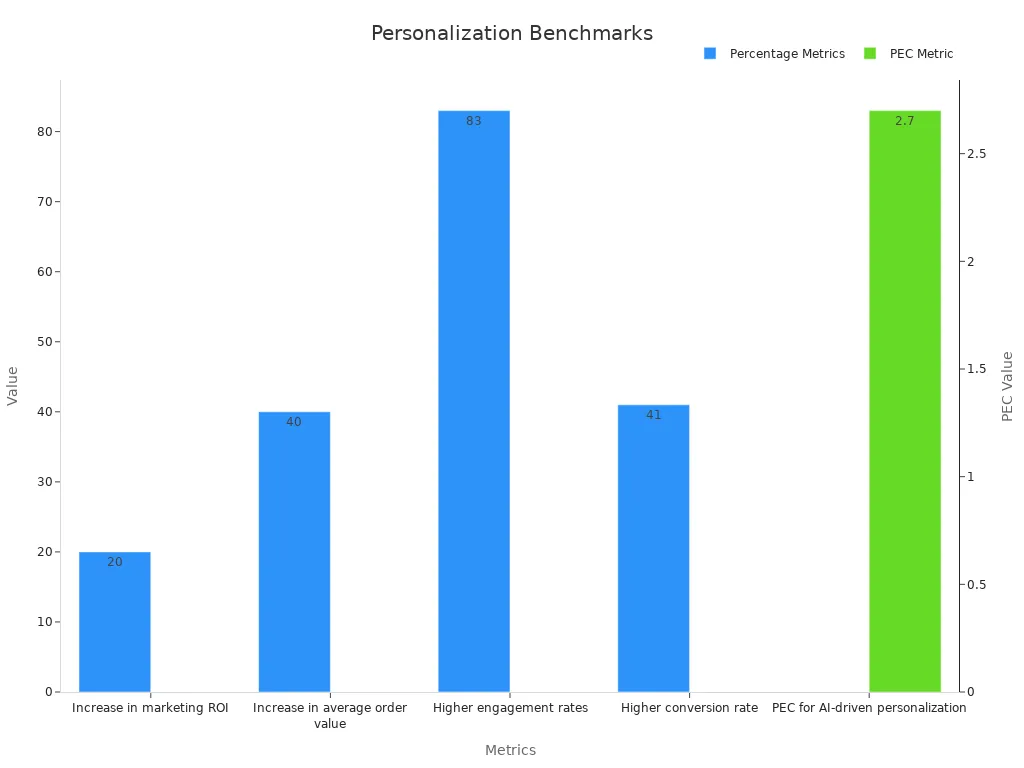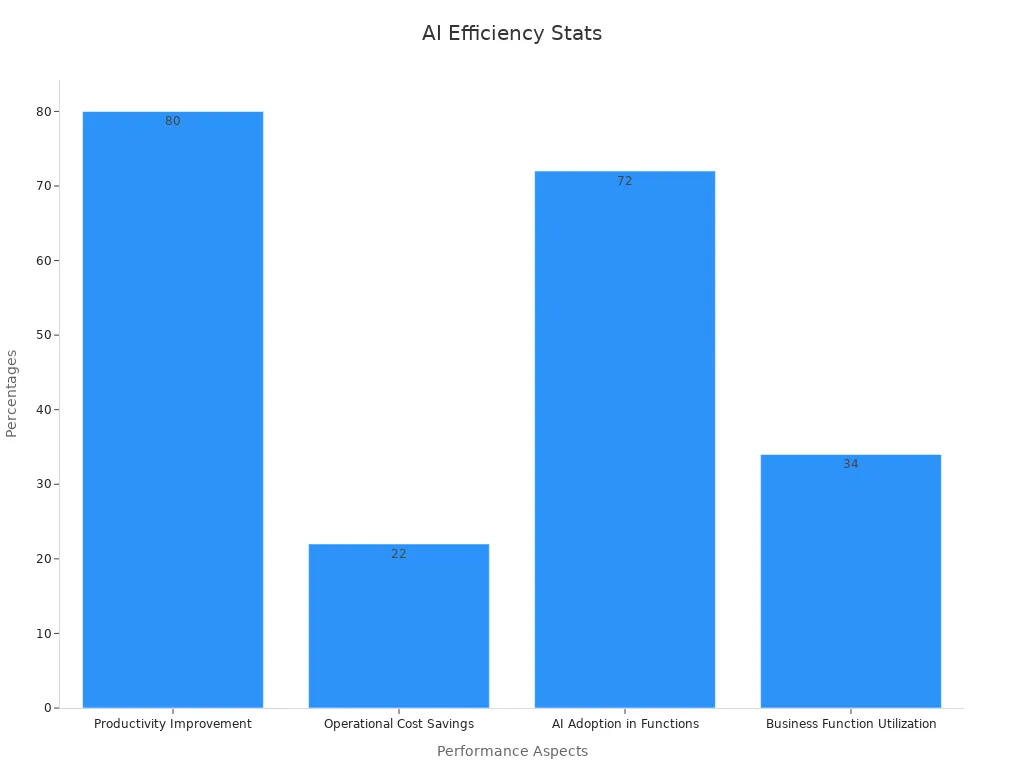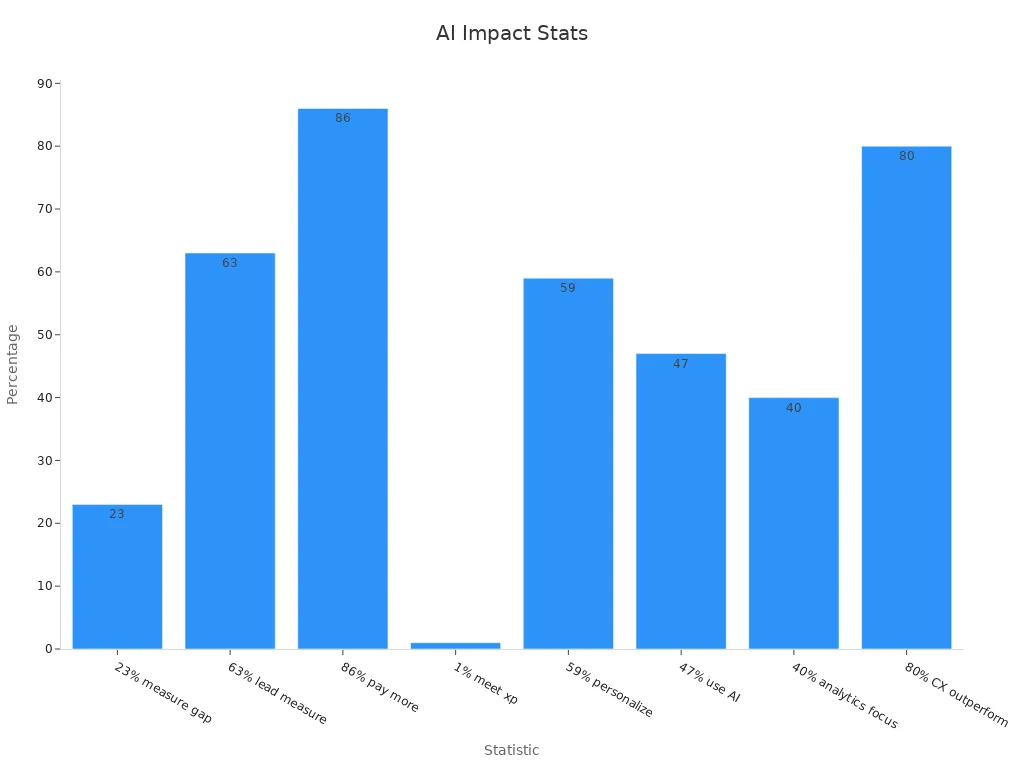AI-Powered Tools for Customer Journey Mapping

AI-Powered Tools are changing how we understand customer journeys. These tools give quick insights by collecting and studying data automatically. They handle big amounts of data easily, helping businesses spot trends and actions right away.
Machine learning and smart predictions find patterns that old methods miss.
Stores using these AI-Powered Tools have seen big sales growth and more profits.
As the market for smart predictions grows fast, AI-Powered Tools are becoming must-haves for making personal customer experiences.
Key Takeaways
AI tools quickly study lots of data to help businesses learn about customer actions.
Mapping customer journeys is key to better experiences. It finds problems and builds loyalty.
Personalizing with AI can raise sales. Companies may see 20% more marketing success.
AI tools handle data work fast, saving time and cutting mistakes. Teams can then focus on helping customers.
To use AI well, businesses must protect data privacy and balance automation with human control.
Understanding Customer Journey Mapping
Defining Customer Journey Mapping
Customer journey mapping shows how customers connect with your business. It tracks their steps, from learning about your product to buying it and beyond. This helps you see things through the customer’s eyes. You can find out what works well and what doesn’t.
There are different ways to study customer journeys, like:
Interviews: Talking to customers helps you learn about their choices.
Field Studies: Watching customers in real life shows hidden problems.
Diary Studies: Customers write down their actions and feelings over time.
Mapping these steps helps you understand customer needs better. You can then plan ways to meet those needs.
Importance of Customer Journey Mapping for Businesses
Customer journey mapping is key to improving your business plans. It helps you focus on giving customers better experiences. Research says customers may pay 16% more for great service. Also, 84% of people think experience matters as much as the product.
Mapping journeys also helps fix problem areas. For example, finding pain points can stop customers from leaving. Studies show 33% of people leave a brand after one bad experience. Fixing these issues can keep customers loyal.
Happy customers often tell others about your business. This can grow sales and lower the cost of getting new customers. Using AI-Powered Tools makes this process faster and more accurate.
How AI-Powered Tools Improve Customer Journey Mapping
Quick Insights and Smart Predictions
AI tools give fast insights and smart predictions. They help you make better choices quickly. These tools study huge amounts of data to find patterns and trends. In retail, AI can manage stock better, cutting inventory costs by 20% and boosting sales by 15%. In factories, AI reduces equipment downtime by 50%, saving $2 million yearly. Below is a table showing how AI helps different industries:
Industry | Problem | AI Solution | Results |
|---|---|---|---|
Retail | Trouble managing inventory | AI predicts stock needs | 20% lower inventory costs, 15% higher sales |
Manufacturing | Delays from broken equipment | AI predicts maintenance needs | 50% less downtime, $2M saved yearly |
E-commerce | Poor engagement with basic marketing | AI suggests personalized recommendations | 25% more conversions, 15% fewer customer losses |
Financial Services | More cases of fraud | AI spots fraud with high accuracy | 90% fraud detection rate, $5M saved yearly |
Personal Touch and Flexible Mapping
AI tools help create personal experiences for customers. They study customer data to match services to their likes. This makes customers more interested and leads to more sales. McKinsey says businesses using AI personalization see a 20% rise in marketing returns. Adobe reports a 40% jump in average order value. The chart below shows these results:

Faster Data Study with Automation
AI tools speed up data study and make it easier. They handle big data quickly, saving time for planning. Automation avoids mistakes and gives steady results. Using AI lets you focus on ideas to improve customer experiences and grow your business.
Benefits of AI-Powered Tools
Better Understanding of Customer Behavior
AI tools help you learn more about your customers. They study lots of data to find patterns in what people do. For example, they show what items customers like, how often they shop, and what affects their choices. This helps you guess what they might want next.
These insights also show where customers face problems. For instance, if many leave their carts at checkout, you can find out why and fix it. Knowing this helps you make changes that keep customers happy and loyal.
Smarter Decisions and Planning
Decisions are easier with accurate information. AI tools give real-time data to help you act fast. For example, if a product’s sales drop, these tools can find out why. They might suggest lowering the price or changing the description.
With good data, you can also plan for the future. You can spot trends in your market and get ready for changes. This helps your business stay ahead and grow stronger.
Better Customer Experiences
Customers want special, personal experiences, and AI tools make this happen. These tools use customer data to suggest items, emails, or deals they’ll like. For example, if someone buys sports gear often, you can suggest water bottles or fitness trackers.
Personalized experiences make customers feel important. They’ll come back to shop and tell others about your business. By improving their experience, you build trust and keep them loyal.
Better Efficiency in Operations
AI tools are making work easier in many industries. They take over boring tasks and study large amounts of data. This saves time, cuts costs, and helps businesses focus on big goals. You can do more with less effort, making work smoother and faster.
Looking at numbers shows how AI changes operations. The table below shares key improvements:
Area | Numbers | Explanation |
|---|---|---|
Work Output Growth | Workers using AI get more done | |
Cost Reductions | 22% average savings | AI lowers business expenses |
AI Use in Companies | 72% of businesses | Many companies now use AI |
AI in Marketing/Sales | 34% usage | Helps improve customer connections |
These stats show how AI boosts work and saves time. For example, JPMorgan uses AI to read credit agreements. This task used to take 360,000 hours a year. Now, it only takes seconds. This saves time, avoids mistakes, and lowers costs.
The chart below shows how AI improves work efficiency:

Adding AI tools to your work can make things better. These tools handle hard jobs carefully, so your team can focus on customers. Whether it’s automating tasks, fixing machines, or managing stock, AI keeps your business running well.
Practical Applications of AI-Powered Tools
Examples of AI Tools in Action
AI tools are solving real problems in many industries. Here are some examples:
Nvidia Drive: Makes driving safer by spotting road signs and obstacles.
BlueDot: Warns health groups about diseases using location-based data.
Motif FoodWorks: Creates plant-based foods based on local tastes and seasons.
Telco Systems: Uses LearnAI to predict equipment issues and improve billing.
These examples show how AI helps in areas like transport and healthcare.
Case Studies of Successful Implementations
Companies using AI tools see great results. For example, Nike used AI to make shopping personal, raising online sales by 30%. L’Oréal added AI beauty consultations, increasing online sales by 20%.
AI also improves customer journey mapping by studying customer actions. Businesses using AI analytics report happier customers and better loyalty. Tools like Natural Language Processing and Predictive Analytics help understand feelings and predict actions. These tools help companies plan better and build strong customer bonds.
Industries Leveraging AI for Customer Journey Mapping
AI is helping many industries in unique ways. The table below shows key stats:
Industry | AI Adoption Maturity Index (2024) | Benefits of AI for Customer Journeys |
|---|---|---|
Technology | 60 | Custom products, faster shopping, happier customers |
Automotive | 60 | Smarter decisions, better inventory control |
Aerospace | 60 | Better supply chains, custom services |
Retail | N/A | Predicts customer needs with personalization |
Manufacturing | N/A | Meets demand for better AI-enhanced products |
Healthcare | N/A | Focuses on improving service and satisfaction |
Banking | N/A | Gives insights for stronger customer connections |
These industries show how AI tools are changing customer journey mapping. They help businesses give better experiences.
Challenges and Considerations
Keeping Data Safe and Private
AI tools need a lot of data to work well. This often includes personal details, which can worry customers. Businesses must handle this data carefully. Here are some common problems:
Data Collection and Usage: AI needs lots of data, including private details.
Transparency: Customers may not know what data is collected or why. Clear explanations are important.
Consent: Always ask customers for permission before collecting their data.
Data Security: Protecting data from hackers is key to keeping trust.
To solve these issues, use strong security measures and explain data use to customers. Being honest and secure builds trust and improves relationships.
Tip: Use encryption and check systems often to keep data safe and follow privacy rules.
Fixing Problems with AI Adoption
Using AI tools for customer mapping can be hard. Many businesses face problems that slow them down. For example, 80% of companies struggle with data silos, says Forrester. These silos block accurate customer journey maps.
Other issues include high costs and lack of skills. To fix these problems:
Train your team to use AI tools better.
Connect systems to remove data silos and improve sharing.
Start small with AI projects to save money and reduce risks.
By solving these problems, you can use AI fully and improve customer mapping.
Mixing Automation with Human Input
AI tools can do tasks fast, but they’re not perfect. You need to mix automation with human checks to avoid mistakes and keep trust. Look at accuracy and error rates to see how well AI works.
For example, if AI makes many mistakes, it can upset customers. Watching these numbers helps you step in and fix problems. Customer satisfaction scores also show if AI meets their needs.
Note: Combining AI’s speed with human checks leads to better choices and builds trust.
By keeping this balance, you can use AI to work faster while keeping a personal touch with customers.
Future Trends in AI-Powered Customer Journey Mapping

Smarter Predictions with AI
AI is getting better at predicting what customers need. It uses data from many places to give quick insights. For example, machine learning studies feedback to guess what people might do next. Natural language processing helps businesses reply to questions better. These tools help you plan smarter and improve your strategies.
AI can also check how customers feel using sentiment analysis. This shows what they like or dislike, helping you make things better. Real-time data lets you act fast, while AI tools suggest items based on past choices. These updates make customer mapping more accurate and useful.
New Tech Changing Customer Mapping
New tech like IoT, AR, and VR is changing customer mapping. IoT gadgets collect live data about what people do. This helps you adjust your marketing plans quickly. For example, IoT can suggest deals based on someone’s habits or location.
AR and VR create fun, hands-on experiences for customers. Imagine trying on clothes virtually before buying them. Blockchain also helps by keeping data safe and clear, solving privacy worries. These tools make customer mapping more exciting and secure.
Generative AI’s Big Impact
Generative AI is changing how we map customer journeys. It finds patterns in data that people might miss. This helps you change services quickly. For example, it can suggest the next best step, like a product or message.
Generative AI also makes every experience feel personal. It helps build trust and keeps customers happy. By studying lots of data fast, it becomes a must-have tool for today’s businesses.
AI tools are changing how businesses improve customer journeys. These tools give useful ideas to make customers happier and grow sales. For example, 47% of companies now use AI to make customers more satisfied. Also, 59% of shoppers say personalized experiences affect their choices. This shows how important AI is for creating custom interactions.
But there are still problems like keeping data safe and using AI well. Only 23% of businesses can measure analytics results, compared to 63% of top companies. Fixing these issues can bring big chances to do better.
Statistic | Value | What It Means |
|---|---|---|
86% of buyers will pay more for better service | 86% | Customer experience helps increase earnings |
1% of brands meet customer needs | 1% | Big chance to improve customer service |
CX leaders beat others by 80% on S&P 500 | 80% | Shows money benefits of focusing on customer care |

As AI gets better, it will change customer mapping even more. Companies using AI will stay ahead, offer new ideas, and build stronger customer bonds.
FAQ
What is customer journey mapping?
Customer journey mapping shows how people connect with your business. It follows their steps from finding your product to buying it. This helps you see what they need and make their experience better.
How do AI-powered tools improve customer journey mapping?
AI tools study lots of data very fast. They give quick insights, guess what customers might do, and make experiences personal. This makes mapping easier and more accurate.
Are AI tools suitable for small businesses?
Yes, small businesses can use AI tools too. They save time, cut costs, and give helpful ideas to improve customer service. Many tools are made to fit smaller businesses.
How can AI tools ensure data privacy?
AI tools keep data safe with encryption and secure systems. Always follow privacy rules and ask customers before using their data. Being honest builds trust with your customers.
What industries benefit most from AI-powered customer journey mapping?
Industries like retail, healthcare, banking, and manufacturing gain a lot. AI helps them offer personal services, predict needs, and work more efficiently.
See Also
Achieving Success in SaaS Content Marketing: The Complete Guide
Enhancing Audience Interaction Using TikTok Data Tools Effectively
Discover SEO Success: Ten Free Tools for Keyword Research
Writesonic AI and QuickCreator: A Content Creation Showdown
A Comprehensive Guide to Conducting Competitor Analysis Effectively

